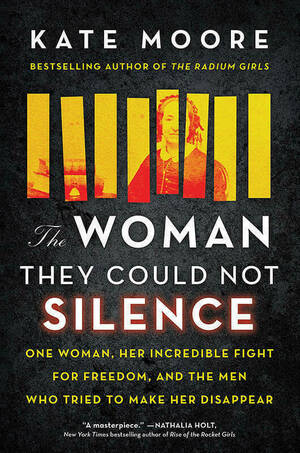A woman locked up in her own home, then forcibly removed to an insane asylum, sounds like the plot of a modern-day horror film. But truth really can be stranger — and at times more terrifying — than fiction.
That’s what struck me as I read British author Kate Moore’s latest dive into the past, The Woman They Could Not Silence: One Woman, Her Incredible Fight for Freedom, and the Men Who Tried to Make Her Disappear.

I picked it up because I was greatly moved by Moore’s 2017 book, The Radium Girls, about the girls and young women who were exposed to radium in the paint used in many watch factories across the United States in the early 20th century. Survivors fought to strengthen workers’ rights, even as many victims faced agonizing deaths from radium poisoning. That book became the basis for a 2018 Netflix film.
The Woman They Could Not Silence is another story about women fighting back. In this case, the real-life heroine is Elizabeth Packard, a 43-year-old housewife and mother of six who lives in rural eastern Illinois in 1860. As the nation teetered on the brink of the Civil War, Packard was fighting her own battle against her Calvinist preacher husband, Theophilus.
Moore again demonstrates her meticulous historical research skills and captivating storytelling to bring this true tale of a 19th-century Midwestern female role model to a modern audience.
Years into a loveless marriage, Elizabeth Packard found inspiration in reading about the landmark women’s convention held in Seneca Falls, New York, in 1848, a gathering that prompted decades of national debate about women’s rights. Accounts of the convention helped Packard find her own voice. “I have got a mind of my own,” Elizabeth later wrote, “and a will, too, and I will think and act as I please.”
A former teacher and school principal, Packard was naturally blessed with a rare command of language, Moore writes. Her husband grew jealous of her, and his jealousy festered into rage.
In Illinois and many other states during the antebellum era, it was legal for a woman to be locked in an asylum based on the wishes of her husband, father or other close male relative. For married women, all that was required was the word of the husband and the permission of the asylum superintendent.
Terms such as “the insane,” “lunatics” and “maniacs” were widely used at the time to describe the mental health of people who didn’t adhere to social norms, including women who refused to obey their husbands. Among reasons listed for these institutionalizations were novel reading, hard studying and disappointed love, Moore writes.
Theophilus Packard had his wife forcibly admitted to the Illinois State Hospital for the Insane in Jacksonville. She spent three years within its walls, pressured by the doctors there but refusing to agree that she was insane — or to back off from her religious views.
At the asylum, Elizabeth befriended other incarcerated women — women who were not mentally unstable but had been locked up as a means of control. From hygiene to the restraints used on patients, conditions in some of the wards at Jacksonville were appalling.
The asylum’s superintendent was Dr. Andrew McFarland, a man Elizabeth first perceived as a gracious friend before she realized his dangerous and duplicitous nature. McFarland turned out to be a master of gaslighting, more treacherous even than Theophilus Packard.
But Elizabeth Packard was capable of defending herself. Her greatest weapon proved to be her pen — and the hidden, detailed journal she kept while incarcerated. While the war raged on, she fought against the system that unjustly imprisoned many women for speaking their minds.
Eventually Packard was released — ironically, after doctors pronounced her incurable and agreed to discharge her. Still under the control of her husband, she eventually obtained what she had long sought: a courtroom trial to demonstrate her sanity. She was her own star witness.
Packard was a force to be reckoned with — a powerful figure destined to improve the lives of others. She became a bestselling writer, a public speaker and a political activist campaigning for the rights of women and the mentally ill. Her work changed laws and improved conditions in mental institutions across the country. “The more freedom I have,” she once wrote, “the more I want.”
Elizabeth Packard is a genuine American hero whose name and deeds deserve to be much more widely known. With The Woman They Could Not Silence, Moore grippingly conveys the consequences of her courage and tenacity.
Margaret Fosmoe is an associate editor of this magazine.